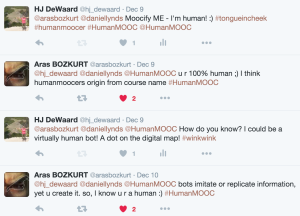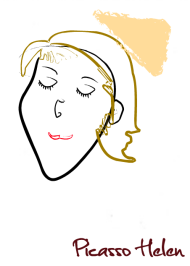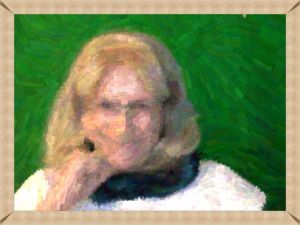Mirror mirror on the wall, who’s the …… ?
This line usually ends with something about being fair or beautiful or kind. Today I’m wondering if the screen on my computer can act as a mirror to reflect my human-ness, my digital self portrait, to show who I am and where I’ve been in online spaces.
This wondering is coming from a combination of things. Maybe from the final assignments I’m marking or from the stream of humorous tweets shared with other #HumanMOOC participants about being human online. How can I ensure I’m creating human interactions or am I talking to a cyber-bot? How is my self portrait painted online?

Conversations in Slack, for example, can have quirky injections from the Slack-bot who’ll make suggestions or recommendations. According to @arasbozkurt bots imitate and replicate, they don’t create!
So my blogs, tweets, and web creations are my human representations of my ‘self’. My reflection in the mirror of my screen, and the ping-backs and retweets, paint a picture of who I am and where I’ve been. This connects and reflects the work I ask my students to do as they enter into new digital spaces, many of them beginning to blog for the first time.
My screen, and the interactions I see and create, paint an image of my digital self portrait. These zeros and 1’s, written in codes many of us never see, lay out a pattern of colours and shapes to paint my image in digital space. My creations – images, text, audio, video, recordings, mashups or memes – shape my image and portrait. I paint my digital self by the choices of tools, resources and spaces where I share and create.
Do I control or paint my own self portrait or do others control the choice of brushes, colours, or canvas? How do I make thoughtful, mindful, visible choices that add tone, tint, and background to the portrait that I paint? How does the portrait emerge from the dots and swooshes of colour and text?
I think, and hope that I am an attentive and cognizant painter of my digital self portrait.
- Colours swirling in my digital self portrait include blues (Twitter), oranges and reds (my blog), greens (for all things Google), mauves for MOOC experiences and teal for @VirtuallyConnecting.
- Shapes include circles (G+, PLN’s) and squares (hangouts, storify curations).
- Backgrounds include gardens & streams (@HumanMOOC), trees & roots (#rhizo15), and towers (LMS, course production, teaching).
- Brushes I use include the wide/broad brush of Twitter, the short/stubby blogging brush, the thin brushes of Facebook and LinkedIn, and the multi-purpose brushes of web design and Google tools.
- My canvas is constructed from my K-8 education experiences and current higher education presence. It is a layered and solid space to paint.
- Others add splashes of new and interesting colour combinations to my image, as one of my students did recently by adding this Go-Animate production to her blog.
I learn from watching how others paint their digital self portraits. For those who are in academic spheres, this recording of Who are You online? A blog talk discussion recorded on April 15 2015 shares insights and ideas about where to start painting. Participants talk about digital identity for scholars and academics using social media. This conversation reminds me that it takes time to paint with mindfulness and vigilance. Expecting my portrait to be finished quickly and ready for showing is unrealistic.
 This week’s conversation with Kate Bowles about Being Mindful, as part of the HumanMOOC course, reminds me to paint with self-awareness and to share my painting process as a lesson for others. I can model an awareness of the canvas and a responsive to new elements as I plan the picture. Kate’s conversation reminds me to be comfortable in the human struggle and messiness when painting my digital self portrait. It reminds me that my portrait is not a mirror image or a screen reflection. It’s nice to catch glimpses of the human side ‘over the shoulder’. It’s not created by bots with dots calculating equations to produce my portrait.
This week’s conversation with Kate Bowles about Being Mindful, as part of the HumanMOOC course, reminds me to paint with self-awareness and to share my painting process as a lesson for others. I can model an awareness of the canvas and a responsive to new elements as I plan the picture. Kate’s conversation reminds me to be comfortable in the human struggle and messiness when painting my digital self portrait. It reminds me that my portrait is not a mirror image or a screen reflection. It’s nice to catch glimpses of the human side ‘over the shoulder’. It’s not created by bots with dots calculating equations to produce my portrait.

I intentionally select to represent myself in digital spaces with a self portrait rather than a digital footprint or a digital tattoo. I’m not creating an imprint in the dirt, left behind to be shaped by wind or weather. I’m not carrying an image impressed in my skin that can’t be changed or adapted without serious laser surgery. I’m painting as I go. Selecting as I emerge from the canvas of past and present.
My portrait is a work in progress, perhaps never to be completed. It’s not a Picasso or a Van Gogh, though I’ve played with Picasso style images in digital space and can create Van Gogh style effects in photo manipulation sites.
So, mirror mirror on my screen. Watch and see what I become! For now, I’ll paint on! I have some blank canvases yet to reveal the portraits to come.
How do you paint your portrait in digital spaces. What choices do you make in technique or colour palette? What subject matter will be in the foreground or background? How do you control the brushes and strokes that shape your image?
Step up. Paint on. Your digital self portrait is yet to be revealed.

Choices we took make us human and shape and define our reflection on digital sphere…
….. and reflect back to us our own humanity. How we ‘talk’ to others, how we respond to others (particularly when it’s challenging to do so) and how we extend hospitality.
Hello Professor DeWaard,
I really enjoyed this post, it had a lot of insightful concepts that I hadn’t yet considered myself. The part that I enjoyed the most however was definitely the theatrics of the post, discussing the impact and the effects the different colours and shapes of the different media sites have in painting your portrait.
Something I’ve found while online as a digital citizen is that traditionally people refer to this concept sometimes as the their aesthetic, and that it is often reflected in the tone of their posts, the content of the blogs, the medium used, and the actual visual aspects, including the colour layouts and any extras details added in. All of this together invokes not only a digital portrait but feelings that people will often share with the poster and help them relate to them better.
I myself am often thinking about the thematic elements and the content of my own personal blog. I try to reblog and post content to paint myself as an individual that that is open and welcoming to those who want to discuss common interests while creating a calm environment to keep them from being nervous to do so. I intend to try and carry this theme and tone over to my own professional portrait so that students will never feel nervous about approaching me online even when they are still getting to know me.
Having said that, my question to you is: What do you think the best strategy for conveying this open and friendly tone while maintaining a professional tone? I’m worried about this because I usually do this by posting light-hearted music and forest scenery, but I’m not sure cluttering a professional blog with this content would be a good idea. I was playing with the idea that the banner on say twitter or other image based sites could be a relaxing photo with possibly a song pinned as the top post, do you think this would be enough to get the job done? Do you have any recommendations for me?
I love the comparison you’ve drawn between a painted portrait of yourself and your digital footprint in cyber-space. The idea that everything we do in the digital world makes up a portrait of ourselves in cyber-space, is an intriguing and insightful concept to think about. So many people now-a-days do not think about what they put out into the internet and what they post on social media. What the internet users of today post tells so much more about them than they realize, they are, as you mention, painting a picture. The idea that this picture is never fully complete is also a valuable point to make. I agree that there is never going to be a clear cut ending to our picture, it can always be added to. To answer one of your posted question, I think that we are in control of our own painting, but we are not in control of how others perceive it. It has become almost impossible to decipher who it is we are talking to or learning from on the internet in today’s society, and I think that is partly because we assume there is so much more anonymity to the internet than there really is. To look for the ‘human’ behind the screen is not a natural act for many who use this digital space now, many do not look hard enough to see the painted picture you described. Too many people seem to use this digital realm to play out a kind of alter ego, so is their digital portrait truly representative of them? Or is that picture painted to displace a separate being?
Hello Professor DeWaard,
Thank you for sharing your imaginative view of creating a digital self-portrait. I specifically admire your use of imagery when you explain the different colours and shapes that are used to create your personal portrait through the different outlets of social media you yourself use. I also appreciate the way in which you encourage people to take their time when developing their digital portrait; I can most definitely agree that developing your online personality takes time, and it definitely “unrealistic” to think otherwise. I myself truly enjoy the process of developing my online portrait and like the notion of embracing my “human-ness” when creating and using social media accounts. I want to be genuine and portray the truest version of myself online as an educator, and reading blog posts such as this one make me think about how I control the way I paint my own digital portrait.
Your blog post has made me think about how my digital portrait is ever-changing and not set in stone; my colours can change and my brush strokes can take a different pattern because I am constantly changing and developing with my portrait.
With that said, how should I create my current portrait even if it is ever changing? Do I allow myself to explore new colours and symbols in order to continue the development of my self-portrait or, should I continue exploring social media in the way that I am already familiar with? How can I develop a self-portrait for myself as an educator? Moreover, how should my portrait as an educator differ from my current portrait as a student?
Hello Professor DeWaard,
Thank you for writing this post I found it quite interesting. Your analysis of the visual digital media and the portrayal of one’s self in the online context was very intriguing, mainly the way one shows their identity and conveys their personality in the online world. As you mentioned: “Your digital self-portrait is yet to be revealed”. This concept of the revealing of one’s self-portrait both confuses and interests me. Can anyone really be their true self online? The way you can show emotion and your personality online does not always directly relate to the actual personality of the individual. Sarcasm does not always translate well online and any things can be misinterpreted. I tried the program that you mentioned in your post using the Van Gogh Style effects. I enjoyed the style changes it made to one of my favourite self-portraits. Thinking about my own self-portrait my current portrait as a University student which will differ greatly than that of a teacher in the future. How do you think that this transition would occur effectively? As well, do you think that one can truly reflect one’s self fully online?
Hi Lauren. Thanks for adding your voice to this conversation. Do I think that people can be their true selves online? Absolutely – in fact I think that to do anything less would be dishonest and dishonourable. Just as we should do in real contexts, in face-to-face scenarios, we shouldn’t be wearing masks but revealing our identity in what we say, how we say it, and what we share. As a citizen of the world, that is my responsibility as a human being. As a digital citizen, in online spaces, that is my responsibility as an engaged member of the community, whichever communities in which I belong.
Your question about the transition from student to professional, as a teacher, can be a difficult one but one that you can control and manage in the years you are at the faculty of education, and as you transition into the world of education. It’s worth doing, and worth spending time doing right! Finding educators who are managing their online identities are great models for you to learn from & with. Helen
Hi Helen,
I enjoyed reading this particular blog post this week. It is so important as a human being to show your humanness in the real world and the digital world. I like your unique title ‘Mirror mirror on the wall, who’s the…?’ I believe this is a great way to grab the reader’s attention and a great introduction into your blog.
I too, try to be my more respectful and authentic self on and offline. It is so important as a human being to always be mindful of others and how your words may affect and reach them. I like the ‘Picasso Helen’ you created. What a unique, fun and beautiful piece of art you have created. Thanks to your blog, I now know what Picasso style images are and can create my own! I had never heard of this before and think that it is super awesome!
I also have many black canvases yet to reveal the portraits to come, and I look forward to furthering my positive digital footprint!
Thanks for adding your comment here Samantha. I’m glad the title captured your attention. At one point I worked on trying to craft the perfect title for blog posts and even searched “how to write a catchy blog post title”. I think it comes back to what you want any reader to gain from what you have written and if it’s even worth stopping by to read your post.
I’m glad you found the Picasso image styles interesting. There are lots of different ways to create personalized avatar-style images that you can use in social media to represent your ‘self’. Some folks change these images up frequently while others keep the same one consistently across all social media accounts. I tend to have a variety of images in a variety of locations to add ‘variety’ to my digital presence. How do you think you’ll manage this? You have future canvases to reveal – create with intention! Helen
Hello, Professor DeWaard,
I chose to examine this particular post for this week as the title really caught my eye! What a cool way to capture the attention of readers! When I hear the phrase “Mirror mirror on the wall…” I am reminded of the Disney movie Snow White and the Seven Dwarfs, however, I have never thought of my online presence as a mirror! I enjoy that you referenced your digital portrait in relation to the colors correspond to the online tools that you use, I have never thought of colors being a part of my digital persona so thank you for sharing! I believe that you are the painter of your own digital self-portrait, and I must say you are creating a wonderful digital masterpiece! I love the idea that you are painting as you go so that you are not an imprint in the dirt left to be filled over, I think that this is something that all should live by when creating their presence online! I also appreciate the links that you have provided such as Picasso Style Images, and Van Gogh style effects as I know that I will be tinkering with these as a part of my online experience! Thank you for sharing your knowledge and tips for creating a digital portrait!
Thanks for sharing this comment, Emilee. I’m glad the title caught your attention – getting catchy titles just right is a gift that sometimes comes from a quote, clip, or an idea. In this case, it just resonated as I tried to capture the ‘reflection’ of my thinking. I’m also happy you found some new digital tools to tinker and play with – there are so many fun little apps and gadgets that it’s often hard to focus on one or two when teaching. There are lots of them that never make it into the full bank of course related tools like you’ve experienced in 3910CDL. Maybe I’ll see your Picasso or Van Gogh image in your final blog post for the course? If not, I know there will be many other future opportunities for sharing your digital reflections. Helen